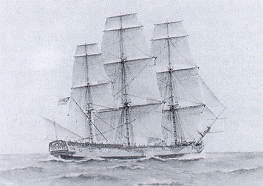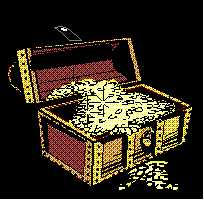
The million that was supplied Saint-Simon to pay his troops by the "Ladies of Havana"...may, with truth, be regarded as the "bottom dollars" upon which the edifice of American independence was erected.*
In 1777-78 George Washington and his troops were in dire need. The Revolutionary forces were in desperate shape and near mutiny because there was not enough money for supplies.
In 1780 Admiral de Grasse was on his way from France to America with a powerful French fleet. He stopped in Haiti in the West Indies for reprovisioning. There he got word from Rochambeau, Commander of the French Forces in America, about the tragic economic situation of the American revolutionaries. De Grasse sent Saint Simon to nearby Cuba with an appeal. In Cuba Francisco Miranda heard about the situation and organized a fund- raising drive.
One particular group, the "Ladies of Havana" responded with great enthusiasm. Over 1,200,000 pounds of silver (25 million dollars in today's equivalent) were collected within a few hours. This generous offering was made to the American and French military not as a loan, but as a willing gift.
Admiral de Grasse proceeded northward to unite his navy with the Revolutionary forces. The silver was divided between Washington and Rochambeau, and the army was able to move ahead toward their destined victory against the superior force at Yorktown in 1781.
And NOW the American people and officials have forgotten or never knew what the Cuban ladies said when they asked for the money in Havana. The Cuban ladies said that the purpose of the gift was "So the American mothers' sons are not born as slaves.
Now the American sons are free. And the Cubans need help. The Cuban exiles are now asking the American nation to NOT support Castro's regime. The Cubans are not asking for a free favor. It's a privilege which they have earned through their efforts and sacrifices. Let's not support Castro. Let's maintain the embargo.
___________________
*When the French Were Here by Stephen Bonsal, Doubleday, Doran
and Company, Inc. 1945, pp. 119-120.
by Lillian Martinez
Source: RECE newsletter, P O Box 011898, Miami, FL 33101. February 1975
More info from the newsgroup soc.culture.cuba:
Date: Tue, 4 Jul 2000 09:42:27 -0700 (PDT)
Larry:
"Los Otros Extranjeros en la Revolucion
Norteamericana", pages 126, 127,128, by Herminio
Portell Vil�, ISBN 0-89729-173-5, 1978, Ediciones
Universal.
The reaction was extremely
favorable, especially among Cuban women who donated
their money and their jewelry and convinced their
relatives and friends to contribute to the
fund-raising...Cuban women got together (to raise) one million
and two hundred "tournesse pounds"...the frigate
L'Aigrette...to pick up the collection in Havana and
Matanzas...to sail to Virginia.
..and Steve Bonsal, perhaps the first American
historian in write this topic said"...the million that
St. Simon was given by the Havana ladies to pay his
troops, might well be considered as the foundations
over which the building of the American independence
was erected", When the French Were Here", Stephen
Bonsal, Fort Washington, N.Y. 1945, pags. 119-120.
My translation.
--- Larry Daley
In "Farewell young Elian - Our Prayers Are With
You," The Washington Times,
Editorial Section, by Antonio Benedi is a
former special assistant
freedom-loving Cuban alive. Many Cubans bravely
fought on U.S. soil in the
War of Independence.
Cubans, as a people, helped raise
much-well
documented. The inscription
that the
"Ladies of Havana" wrote on their contribution was:
"So the American mothers' sons are not born
as slaves."
The pledge of the Havana's Ladies, remained
very little known, with
the exception of an American historian Stephen
Bonsal, who wrote: "That sum
collected [by the Havana's Ladies] must be
considered as the ground whereon
was erected the American independence."
Gen. Jean Baptiste de Rochambeau wrote in his "Daily
Memoirs," available in
the Library of Congress: "The joy was enormous when
it was received, the
money from Havana: The contribution of 800,000
silver pounds which helped
stop the financial bankruptcy (of the Revolutionary
Army) and raised up the
moral spirit of the Army that had began to
dissolve."
Carmen Maria Rodriguez has also done research into
this chapter of the
Revolutionary war. She writes:
This July 4th, New York will be scenario of the
largest maritime event in the
history of humankind. In this regard, the city, and
the nation are outdoing
themselves to stage along with simulatenous
fireworks, one of the most
impressive displays of popular joy and freedom ever
staged commemorating a
nation's freedom.
A friend of mine, Tirso Gonzalez, veteran of the
2506 Brigade, once heard me
talking about this case, and both he and I sent out
to investigate in the NY
Public Library if this indeed was true. This is
what we both found out:
General George Washington had a dream to liberate
the colonies from the
English. He also had a band of mercenaries whom to
pay, since he relied on
these type of soldiers to wage the war which he felt
was just and necessary.
The French were here in the colonies helping out,
and given that there was no
money to finance the mercenaries or the war,
Lafayette commanded the frigate
known as "L'Aigrrette", to travel first to Cadiz,
Spain, to see if money
could be gotten. To no avail, the Spanish in Cadiz
were very kind but not
financially forthcomming. The ship then went on to
Saint Domingue, what is
now Haiti, and what was then the riches of all
colonies given the enourmeous
wealth to be had in the sugar industry. The French
there told the French on
the ship, "Nous n'avons pas d'argent", in other
words, there would be no
money from Saint Domingue sent to Washington.
L'Aigrette then set sail to
the Port of Havana to obtain water and supplies to
return up to Virginia. It
was there that word got out, our traditional "Radio
Bemba" of the time, that
Washington needed funding to stage a battle which
was at the time only in the
planning stage. Women, girls, from Havana, to
Matanzas to Pinar del Rio gave
freely of their jewelry, the French even documenting
that they disposed of
their diamonds, to help Washington in his quest for
freedom and his financing
of his mercenaries.
The women of Cuba came forth,
knowing that this was a
just cause, giving up of their only wealth which was
their gold, to assist
the love of independence of another nation. When
L'Agraitte set sail and
arrived in September of 1781 in Virginia, General
Washington upon knowing
that there was sufficient financing of over
1,200,000 pounds of Cuban gold,
silver and diamonds, historians point out that he
lost his usual sedate
composure and threw his hat in the air from sheer
joy. Cuban Women's
Contribution to the cause of American Independence
thus made possible the
financing of the decisive battle of American
Independece, known as the
Yorktown Battle. In fact, it was then on 31 October
1781, that General
Cornwallis of England, had his sable turned over to
General Washington, as a
sign of surrender of the English to a band of
dreamers know as the Founding
Fathers of the United States of America. May G-d
bless the children of these
Cuban women who loved their own freedom, but knew
that the cause of liberty
and justice is one to be pursued at all costs
everywhere in the world where
there is need for such a state of affairs.
"...Cubans...made a donation...for the battle of
Yorktown...most of the treasure brought from
Cuba was intended to pay the French around 800,000
tournesse pounds...another 400,000 tournesse pounds
were used to pay the soldiers of Washington
troops...The weight of the one million two hundred
tournesse pounds was so heavy that it was necessary to
reinforce the floors of the Yorktown house where the
money was deposited to be shared by soldiers and
sailors...", page 128, my translation of the same book
cited previously.
From: robert solera
To: Larry Daley
Subject: Re: Cuban support for American Independence (fwd) "Miranda when he learned of the failure of St. Simon
mission he used his closeness to the Captain General
of Cuba. Enthusiastic supporter of the American
Revolution himself, he knew it was a popular cause
amongst his Cuban friends and he enquired among them
as to their willingness to participate in fund-raising
for the Admiral De Grasse and George
Washington armies.
"Miranda when he learned of the failure of St. Simon
mission he used his closeness to the Captain General
of Cuba. Enthusiastic supporter of the American
Revolution himself, he knew it was a popular cause
amongst his Cuban friends and he enquired among them
as to their willingness to participate in fund-raising
for the Admiral De Grasse and George
Washington armies. Being Cuban born and living within sight of the
Statue of Liberty, I cannot
help but think of who and what made this possible.
My mind races back to a
demonstration held in New York by Cuban Americans
when someone handed to me a
piece of paper in which the former US Ambassador to
Cuba Stephen Bonsal
wrote, "The Contribution of Cuban women by way of
their jewelry, could very
well be the foundation on which is founded, the
freedom of the United
States". Bonsal, having lived in Havana, also
penned a book, "When the
French were here".
Being Cuban born and living within sight of the
Statue of Liberty, I cannot
help but think of who and what made this possible.
My mind races back to a
demonstration held in New York by Cuban Americans
when someone handed to me a
piece of paper in which the former US Ambassador to
Cuba Stephen Bonsal
wrote, "The Contribution of Cuban women by way of
their jewelry, could very
well be the foundation on which is founded, the
freedom of the United
States". Bonsal, having lived in Havana, also
penned a book, "When the
French were here". When New York rejoices this Fourth of July, I too in
a way shall rejoice
doubly, since it was our Cuban ancestors, and
despite all the disdain for
Cubans present now in this land, that made possible,
the freedom and bounty
of so many. And by writing this, I hope to start
waking up people's minds
that Cubans even today as in 1781, maintain their
unique tradition of
defending freedom above all else.
When New York rejoices this Fourth of July, I too in
a way shall rejoice
doubly, since it was our Cuban ancestors, and
despite all the disdain for
Cubans present now in this land, that made possible,
the freedom and bounty
of so many. And by writing this, I hope to start
waking up people's minds
that Cubans even today as in 1781, maintain their
unique tradition of
defending freedom above all else.
 Return To:
Return To: